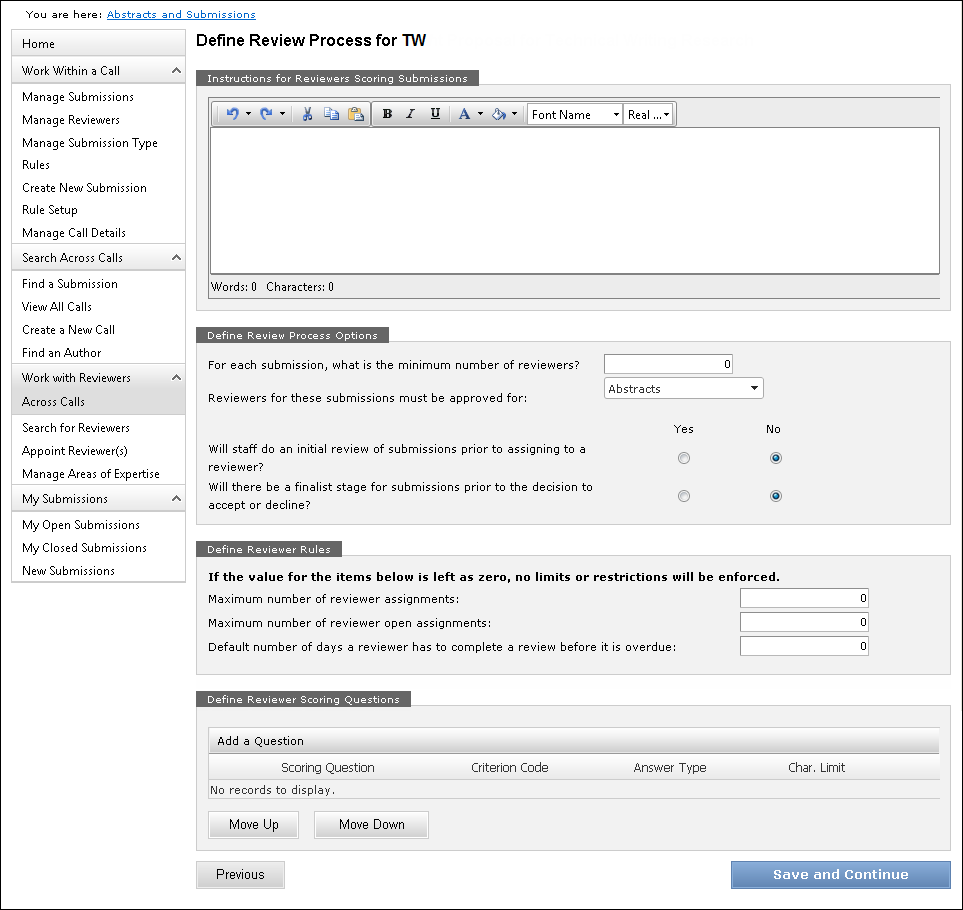The Define Review Process screen displays, as shown below.

Part of defining a submission type is defining how the review process will be structured for the submission type. When the review process questions are answered, the system has enough information to be able to automate the progression of external status codes and internal status codes on each submission. For more information, please see Internal and External Review Status Codes.
To define the review process:
1. Once
you have created a new submission
type, defined submitter
requirements, defined
submitter disclosure questions, defined
material requirements, defined
submission disclosure questions, defined
content (text block) questions, and defined
rules for file attachments on the Material Requirements page, click
Save Changes.
The Define Review Process screen displays, as shown below.

2. From
the "Define Review Process Options" section (shown below), enter
the following information:

a. For each submission, what is the minimum number of reviewers?: this is the default minimum number of reviewers required per submission. The system evaluates the number of reviewers that have been assigned to the submission against the defined default minimum number of required reviewers in order to determine the internal status code of a submission. For example, if the defined minimum number of required reviewers is "3", until three reviewers are assigned to the submission, the internal status of the submission will remain as "Need reviewer invite". The value in this field defaults to the minimum number of assigned reviewers for each submission for this submission type.
b. Reviewers for these submissions must be
approved for: this identifies the type of material that a reviewer
selected for this submission type must be approved to review. Only reviewers
with a current, active term, who have the same REVIEWER_APPROVED_FOR code
as defined for the call submission type here can be assigned to the call
submission type and submissions within that submission type.
If an organization wants to be able to assign any current reviewer to a
call submission type, the REVIEWER_APPROVED_FOR code for the call submission
type can also be set to "ALL". If the REVIEWER_APPROVED_FOR
code for a call submission type is NOT set to "ALL", reviewers
with an REVIEWER_APPROVED_FOR code of "ALL" can still be assigned
to that call submission type.
c. Will staff do an initial review of submissions prior to assigning a reviewer?: select whether or not the staff will do an initial review of all submissions, which is manual, before assigning a reviewer to submissions. This is used by the system in the automated calculation of the internal status code of a submission. If a staff review stage is being used, once a submission is submitted in final, the internal status code goes immediately to "Need staff review". If a staff review stage is not being used, once a submission is submitted in final, the internal status code goes immediately to "Need reviewer invite".
d. Will there be a finalist stage for submissions prior to the decision to accept or decline?: select whether or not there will be finalist stage for submissions prior to making the decision of whether to accept or decline a submission. If you select "Yes", make sure to define the maximum number of finalist submissions in step 8b. If a finalist stage is being used, once reviewers complete their reviewer of a submission, the internal status code goes to "Need finalist decision". If a finalist stage is not being used, once reviewers complete their reviewer of a submission, the internal status code goes to "Need decision".
3. From
the "Define Reviewer Rules" section (shown below), enter the
following information, as necessary:

a. Enter
the Maximum number of reviewer assignments.
By default, this is set to zero. If you do not change this from zero, no
limits or restrictions will be enforced. If a maximum number of reviewer
assignments has been defined for the call submission type, the assignment
status for a reviewer cannot be updated to “UNDER_REVIEW” if, in doing
so, it will mean that the reviewer will exceed the maximum number of reviewer
assignments defined for the call submission type.
b. Enter
the Maximum number of reviewer open assignments.
By default, this is set to zero. If you do not change this from zero, no
limits or restrictions will be enforced. If a maximum number of
open reviewer assignments has been defined for the call submission type,
the assignment status for a reviewer cannot be updated to “UNDER_REVIEW”
if, in doing so, it will mean that the reviewer will exceed the maximum
number of open reviewer assignments defined for the call submission type.
c. Enter
the Default number of days a reviewer
has to complete a review before it is overdue.
By default, this is set to zero. The value entered here is used to set
the Due Date for each reviewer assignment. For example, if "14"
is entered here, the reviewer Due Date will be set to two weeks from the
date they are assigned to a submission.
4. Proceed to define reviewer scoring questions.